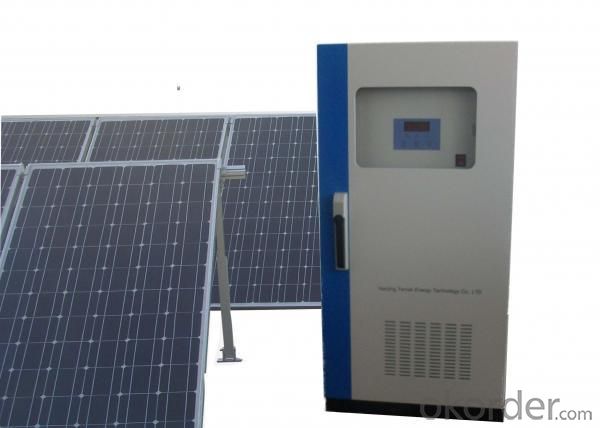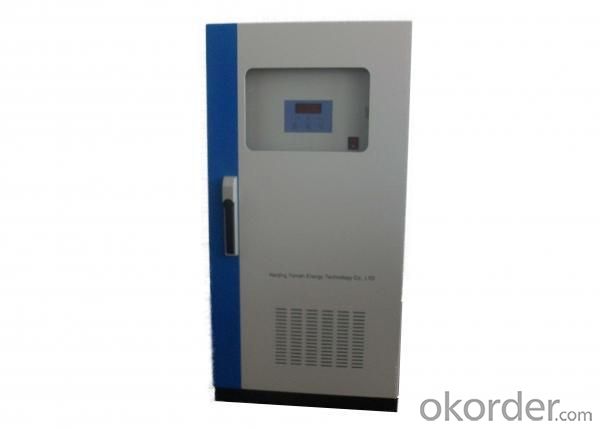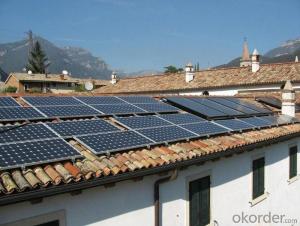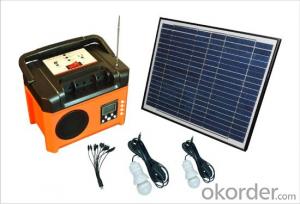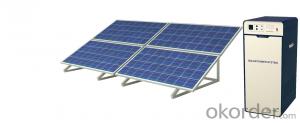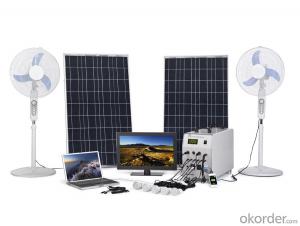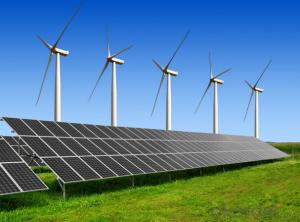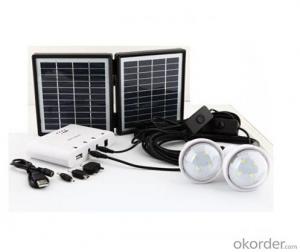CNBM Solar Home System CNBM-K9 (10KW)
- Loading Port:
- China Main Port
- Payment Terms:
- TT or L/C
- Min Order Qty:
- 1 set set
- Supply Capability:
- 1000 sets per month set/month
OKorder Service Pledge
OKorder Financial Service
You Might Also Like
Brief Introduction of Solar Energy System CNBM-K9 (10KW)
CNBM Home System-K9 (10KW) has a wonderful capacity.It can be used in factory,home,school and other CNBM Home System-K9 (10KW) consist of the solar modules,charge controller,inverter and battery banks.
CNBM International is highly recognized by its business partners and clients all over the world and has obtained rapid development under the spirit of win-win .
With CNBM Home System-K9 (10KW),
We will carry on the mutual beneficial,innovative and revolutionary trading structure as we did before,create value for our employees,share holders and clients and benefit the whole society in our future development.Please contact us ,if you have interest in CNBM Home System-K9 (10KW),don’t hesitate!
The Sketching of Solar Energy System CNBM-K9 (10KW)
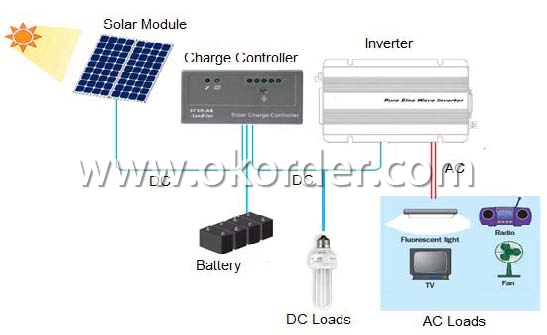
Components of Solar Energy System CNBM-K9 (10KW)
PV Array:
Convert sunlight instantly into DC electric power. Formed by the solar modules (also called photovoltaic modules) in accordance with the system requirements for series and parallel.
Solar Charge Controller:
A charge controller may be used to power DC equipment with solar panels. The charge controller provides a regulated DC output and stores excess energy in a battery as well as monitoring the battery voltage to prevent over charge or over discharge. An inverter can be connected to the output of a charge controller to drive AC loads.
Inverter:
Converts DC output power of photovaltaic soalr panels into standard AC power for use in the local off-grid electrical network. It is a critical component in a photovoltaic system, allowing the use of ordinary commercial appliances.
Battery banks:
Stores energy when there is an excess coming in and distribute it back out when there is a demand. Solar PV panels continue to re-charge batteries each day to maintain battery charge.
Technical data of Solar Home System CNBM-K9 (10KW) | ||
Inverter | Rated load power | 10KW |
Output wave | Pure sine wave | |
Output voltage | DC 220V | |
Output frequency |
AC:220V | |
Precision of output | 50HZ/60HZ | |
Precision of output frequency | ±0.04HZ | |
Solar panel | Pmax | 200W*55PCS |
Vmp | 26.84V*11 | |
Imp | 7.45A*5 | |
Charger | Charger voltage & current | 220V /50A |
Battery | Capacity | 12V /150AH*18*2PCS |
Support | Aluminum | 11PCS/SET*5 |
Power box | Spray paint iron box,with input,output,ammeter,voltmeter,master swith and so on. | |
Package of Solar Home System CNBM-K9 (10KW) | ||||
Part | Size(L*W*H mm) | Weight(kg) | 20’(pcs) | 40’(pcs) |
Power box | 500*550*1500 | 190 | 6 Sets | 8 Sets |
Solar panel | 1482*992*40 | 960 | ||
Battery | 1100*520*650*4 | 2200 | ||
Factory Picture of Solar Energy System CNBM-K9 (10KW)
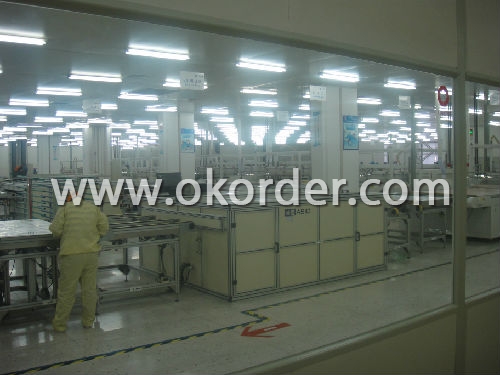
Package Picture of Solar Energy System CNBM-K9 (10KW)
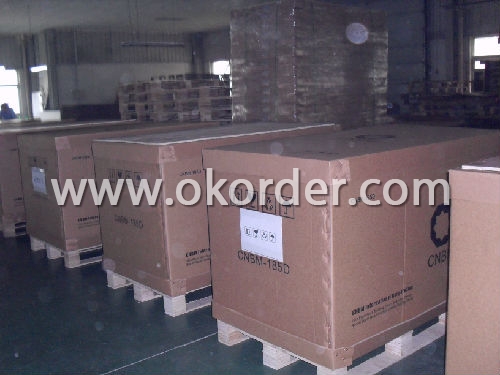
- Q: Can a solar energy system be installed in an area with high wind speeds?
- In areas with high wind speeds, it is possible to install a solar energy system. However, it is necessary to consider certain factors and take precautions during the installation process. To ensure that the solar panels can withstand strong winds, it is important to select panels specifically designed for this purpose and securely anchor them. Additionally, the support structures such as mounting racks or frames should be firmly fastened to ensure stability. Professional installers who have experience working in high wind areas can design and install the system in a manner that prioritizes safety and efficiency. It may also be necessary to adjust the orientation and angle of the solar panels to minimize wind resistance and potential damage. Through careful planning and installation, solar energy systems can be successfully implemented in areas with high wind speeds, effectively harnessing the power of the sun despite challenging environmental conditions.
- Q: Can solar panels be installed on floating platforms or structures?
- Yes, solar panels can indeed be installed on floating platforms or structures. This innovative approach is known as floating solar or floating photovoltaic (PV) systems. These systems consist of solar panels mounted on floating platforms that are placed on bodies of water such as lakes, reservoirs, or even the ocean. Floating solar panels offer several advantages over traditional ground-mounted or rooftop solar installations. Firstly, they can make use of underutilized space on water bodies, where land is limited or expensive. This can be particularly beneficial in densely populated areas or in regions with high land costs. Secondly, floating solar panels can help to reduce water evaporation from reservoirs, lakes, or other water bodies, thus conserving water resources. Additionally, the water beneath the panels can help to cool the panels, improving their overall efficiency and energy output. Furthermore, floating solar panels can be easier to install and maintain compared to ground-mounted systems. They often require less land preparation and can be deployed and relocated relatively quickly. Maintenance and cleaning of the panels can also be simpler, as they can be accessed directly from the water surface. Floating solar systems have gained popularity in recent years and have been successfully implemented in various countries around the world. They have proven to be a viable and sustainable solution for generating clean and renewable energy, while also addressing land constraints and water conservation. In conclusion, solar panels can be installed on floating platforms or structures, providing an innovative and efficient way to generate solar energy while utilizing underutilized water surfaces.
- Q: Can solar energy systems be used for emergency backup power during power outages?
- Yes, solar energy systems can be used for emergency backup power during power outages. Solar panels generate electricity by converting sunlight into energy, which can be stored in batteries for later use. This stored energy can then be used to power essential appliances and devices during power outages, providing a reliable backup power source.
- Q: What is the impact of fire on solar panels?
- The impact of fire on solar panels can be quite significant and detrimental. Fires can cause direct damage to the panels, resulting in their complete destruction or rendering them inoperable. The high temperatures generated by fires can melt or warp the delicate components of the solar panels, such as the photovoltaic cells and the wiring. This damage can make the panels incapable of producing electricity. Furthermore, the smoke and soot generated by fires can cover the surface of the solar panels, reducing their efficiency by obstructing sunlight and decreasing the amount of light that can be absorbed. This can lead to a significant reduction in power output from the panels. In addition to the physical damage caused by fires, the heat and flames can also pose a safety risk to the surrounding area. Solar panels are typically installed on rooftops or in open areas, making them vulnerable to fire hazards. If a fire occurs near or on a solar panel, it can increase the risk of the fire spreading and causing further damage to the property. To mitigate the impact of fire on solar panels, it is crucial to have proper fire safety measures in place. This includes using fire-resistant materials for the installation of solar panels and ensuring that the panels are adequately protected from potential fire sources. Regular maintenance and cleaning of the panels are also essential to remove any debris or soot that may accumulate, thus maximizing their efficiency and minimizing the risk of damage in the event of a fire. Overall, the impact of fire on solar panels can be severe, leading to physical damage, decreased efficiency, and safety risks. It is crucial to take necessary precautions and implement fire safety measures to protect solar panels and minimize potential losses.
- Q: Can a solar energy system power an entire household?
- Yes, a solar energy system has the potential to power an entire household. However, the feasibility of completely powering a household with solar energy depends on various factors such as the size of the system, energy consumption patterns, and location. It is essential to assess the energy needs of the household, consider the available sunlight, and design an appropriately sized solar system to ensure sufficient power generation. Additionally, incorporating energy-efficient practices and technologies can further enhance the ability of a solar energy system to meet the household's energy requirements.
- Q: Can solar energy systems be used for powering off-grid eco-retirement communities?
- Yes, solar energy systems can be used effectively for powering off-grid eco-retirement communities. Solar panels harness the sun's energy and convert it into electricity, providing a sustainable and renewable power source. Off-grid communities can utilize solar energy to meet their electricity needs, reducing their reliance on fossil fuels and minimizing their environmental impact. Additionally, solar energy systems can be easily installed and maintained, making them a practical and cost-effective solution for powering eco-friendly retirement communities that are disconnected from the traditional power grid.
- Q: Can solar energy systems be integrated into building design?
- Yes, solar energy systems can be integrated into building design. In fact, integrating solar energy systems into building design is becoming increasingly common and is considered a sustainable and cost-effective approach to generating electricity. There are various ways to incorporate solar energy systems into building design, including rooftop solar panels, solar facades, and solar windows. Rooftop solar panels are the most commonly used method of integrating solar energy systems into building design. They can be installed on the roofs of buildings, either as standalone structures or integrated into the roof itself. These panels capture sunlight and convert it into electricity, which can be used to power the building or be fed back into the grid. Solar facades are another way to integrate solar energy systems into building design. These systems involve installing solar panels on the outer walls of buildings. They not only generate electricity but also act as a protective layer, reducing heat gain and improving the building's energy efficiency. Solar windows are a relatively new development in building-integrated solar energy systems. These windows are designed with built-in transparent solar cells that can capture sunlight and generate electricity while still allowing natural light to enter the building. Solar windows have the potential to revolutionize building design by seamlessly integrating renewable energy generation into the building envelope. Integrating solar energy systems into building design offers several advantages. First and foremost, it allows buildings to generate their own electricity, reducing reliance on fossil fuel-based power sources and lowering utility bills. Additionally, it contributes to the reduction of greenhouse gas emissions, promoting a cleaner and more sustainable environment. Moreover, solar energy systems can enhance the aesthetic appeal of buildings, turning them into visually striking examples of sustainable architecture. In conclusion, solar energy systems can indeed be integrated into building design. With various options available, including rooftop solar panels, solar facades, and solar windows, buildings can generate their own clean, renewable electricity, reduce their carbon footprint, and contribute to a more sustainable future.
- Q: Can a solar energy system be integrated with other energy sources?
- Indeed, it is possible to combine a solar energy system with alternative energy sources, creating what is referred to as a hybrid energy system. This integration is increasingly prevalent as a means of improving the dependability and efficiency of renewable energy systems. By merging solar energy with other sources like wind, hydro, biomass, or even conventional fossil fuel generators, a hybrid system can offer a more stable and consistent power supply. Consequently, this integration enables the production of energy even during periods of inadequate solar radiation or when sunlight is absent, guaranteeing an uninterrupted power supply. Furthermore, hybrid systems can also incorporate energy storage technologies, such as batteries, to store surplus energy generated by the solar panels for use during peak demand or periods of reduced solar energy production. Overall, the integration of solar energy systems with alternative energy sources can optimize energy production, enhance reliability, and facilitate the transition towards a more sustainable energy future.
- Q: How do solar energy systems impact energy independence?
- Solar energy systems can greatly contribute to energy independence by reducing reliance on fossil fuels and the traditional energy grid. By harnessing the power of the sun, individuals and communities can generate their own clean and renewable energy. This reduces the need to import energy from other sources and helps to decrease dependence on centralized power systems. Solar energy systems provide a sustainable and decentralized alternative, empowering individuals and communities to take control of their energy production and reduce their carbon footprint.
- Q: How long does it take for a solar energy system to pay for itself?
- The payback period for a solar energy system varies based on several factors such as the initial cost, location, energy usage, and available incentives. On average, it takes around 5-10 years for a residential solar energy system to pay for itself through energy savings. However, this timeframe can be shorter in areas with high electricity costs and substantial government or utility incentives.
Send your message to us
CNBM Solar Home System CNBM-K9 (10KW)
- Loading Port:
- China Main Port
- Payment Terms:
- TT or L/C
- Min Order Qty:
- 1 set set
- Supply Capability:
- 1000 sets per month set/month
OKorder Service Pledge
OKorder Financial Service
Similar products
Hot products
Hot Searches
Related keywords



